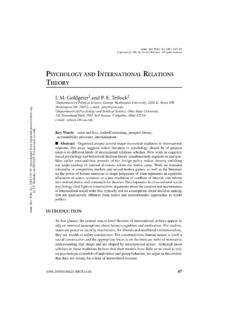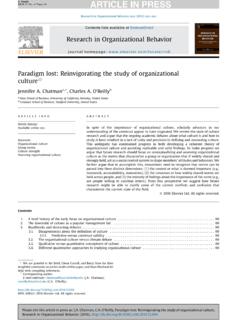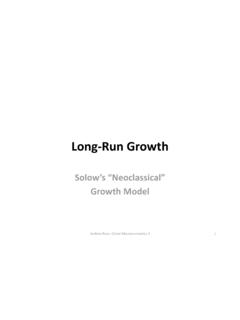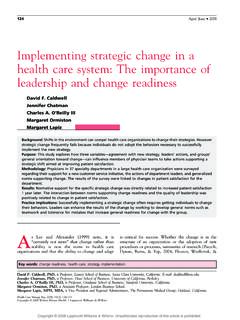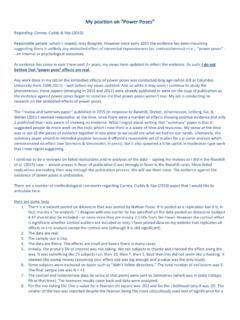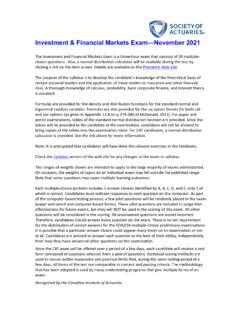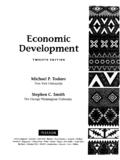Transcription of The Behavior of Individual Investors - Berkeley Haas
1 Handbook of the Economics of Finance 2013 Elsevier All rights M. Barbera and Terrance OdeanbaGraduate School of Management, University of California, Davis, Davis, CA 95616, USA. Tel.:+1 (530) 752 0512bHaas School of Business, University of California, Berkeley , Berkeley , CA 94720, USA. Tel.:+1 (510) 642 6767 The Behavior of Individual Investors *22* We thank Nicholas Barberis, Simon Gervais, Markku Kaustia, Matti Keloharju, Andrei Simonov, Paolo Sodini, Rene Stulz, Sheridan Titman, Stephen Utkus, Jing Yao, and Luo Zuo for comments on this paper. We thank Noah Stoffman for providing us with an analysis of the disposition effect for the Finnish dataset.
2 Laney Smith provided valuable research The Performance of Individual Investors 1535 The Average Individual 1535 Long-Horizon Results 1540 Short-Horizon Results 1542 market vs. Limit Orders 1543 Cross-Sectional Variation in Performance 15442. Why do Individual Investors Underperform? 1547 Asymmetric Information 1547 Overconfidence 1547 Sensation Seeking 1549 Familiarity 15503. The Disposition Effect: Selling Winners and Holding Losers 1551 The Evidence 1551 Why Do Investors Prefer to Sell Winners?
3 15574. Reinforcement Learning 15595. Attention: Chasing the Action 15596. Failure to Diversify 15607. Are Individual Investors Contrarians? 15648. Conclusion 1565 References 1565 The bulk of research in modern economics has been built on the notion that human beings are rational agents who attempt to maximize wealth while minimizing risk. These agents carefully assess the risk and return of all possible investment options to arrive at an investment portfolio that suits their level of risk aversion.
4 Models based on these Brad M. Barber and Terrance Odean1534assumptions yield powerful insights into how markets work. For example, in the Capital Asset-Pricing Model the reigning workhorse of asset-pricing models Investors hold well-diversified portfolios consisting of the market portfolio and risk-free investments. In Grossman and Stiglitz s (1980) rational expectations model, some Investors choose to acquire costly information and others choose to invest passively. Informed, active, Investors earn higher pre-cost returns, but, in equilibrium, all Investors have the same expected utility.
5 And in Kyle (1985), an informed insider profits at the expense of noise traders who buy and sell large body of empirical research indicates that real Individual Investors behave differently from Investors in these models. Many Individual Investors hold under-diver-sified portfolios. Many apparently uninformed Investors trade actively, speculatively, and to their detriment. And, as a group, Individual Investors make systematic, not random, buying and selling costs are an unambiguous drag on the returns earned by Individual Investors . More surprisingly, many studies document that Individual Investors earn poor returns even before costs.
6 Put another way, many Individual Investors seem to have a desire to trade actively coupled with perverse security selection ability!Unlike those in models, real Investors tend to sell winning investments while hold-ing on to their losing investments a Behavior dubbed the disposition effect . The dis-position effect is among the most widely replicated observations regarding the Behavior of Individual Investors . While taxes clearly affect the trading of Individual Investors , the disposition effect tends to maximize, rather than minimize, an investor s tax bill, since in many markets selling winners generates a tax liability that might be deferred simply by selling a losing, rather than winning, Investors are influenced by where they live and work.
7 They tend to hold stocks of companies close to where they live and invest heavily in the stock of their employer. These behaviors lead to an investment portfolio far from the market portfolio proscribed by the CAPM and arguably expose Investors to unnecessarily high levels of idiosyncratic Investors are influenced by the media. They tend to buy, rather than sell, stocks when those stocks are in the news. This attention-based buying can lead Investors to trade too speculatively and has the potential to influence the pricing of this paper, we enter a crowded field of excellent review papers in the field of behavioral economics and finance (Rabin, 1998; Shiller, 1999; Hirshleifer, 2001; Daniel, Hirshleifer, and Teoh, 2002; Barberis and Thaler, 2003; Campbell, 2006; Benartzi and Thaler, 2007; Subrahmanyam, 2008; and Kaustia, 2010a).
8 We carve out a specific niche in this field the Behavior of Individual Investors and focus on investments in, and the trading of, Individual stocks. We organize the paper around documented patterns in the investment Behavior , as these patterns are generally quite robust. In contrast, the The Behavior of Individual Investors1535underlying explanations for these patterns are, to varying degrees, the subject of con-tinuing cover five broad topics: the performance of Individual Investors , the disposition effect, buying Behavior , reinforcement learning, and diversification.
9 As is the case with any review paper, we will miss many papers and topics that some deem relevant. We are human, and all humans err. As is the case for Individual Investors , so is the case for those who study THE PERFORMANCE OF Individual The Average IndividualIn this section, we provide an overview of evidence on the average performance of Individual Investors . In Table 1, we provide a brief summary of the articles we discuss. Collectively, the evidence indicates that the average Individual investor underperforms the market both before and after costs.
10 However, this average (or aggregate) per-formance of Individual Investors masks tremendous variation in performance across research published through the late 1990s, the study of investor performance focused almost exclusively on the performance of institutional Investors , in general, and, more specifically, equity mutual This was partially a result of data availability (there was relatively abundant data on mutual fund returns and no data on Individual Investors ). In addition, researchers were searching for evidence of superior Investors to test the central prediction of the efficient markets hypothesis : Investors are unable to earn superior returns (at least after a reasonable accounting for opportunity and transac-tion costs).
